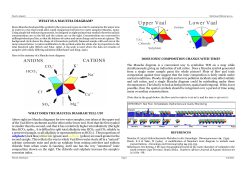
Outcome 1 Topic 3 â Ionic Compounds o Two types of compounds
Outcome 1 Topic 3 ‐ Ionic Compounds o How Atoms Bond http://www.youtube.com/watch?v=NgD9yHSJ29I&app=desktop Two types of compounds we will study in Science 10 are: a. Ionic Compounds ‐ are formed between a cation and anion b. Molecular compounds ‐ are formed between non‐metal atoms o Ionic compounds are neutral and stable compounds o Ionic compounds are formed through the process of ionic bonding. o Ionic bonds form between atoms of metals and non‐metals. o They are formed whenever electrons are transferred from a metal atom to a non‐ metal atom. http://bcs.whfreeman.com/thelifewire/content/chp02/02020.html <http://www.teachersdomain.org/asset/lsps07_int_ionicbonding/> <http://www.bbc.co.uk/schools/gcsebitesize/science/add_aqa/atomic/ionicrev4.shtml> o There are many different ways that ionic compounds can form a. A univalent metal cation + a simple non‐metal anion b. A multivalent metal + a simple non‐metal anion c. Compounds formed with polyatomic cations and/or anions A. A univalent metal cation + a simple non‐metal anion o Univalent means ‐ an element that has only one possible ion form E.g. Sodium has only one ion ‐ Na+ i. simple metal + simple non‐metal → ionic compound Sodium + chlorine → sodium chloride Example 2: Lithium + fluorine → Write the balanced chemical formula for the compound: Example 3: Word Formula: Magnesium + Bromine → Write the balanced chemical formula for the compound: 1 Naming Ionic Compounds: o All ionic compounds are made of two parts: a cation and an anion o Therefore names of ionic compounds also have two parts: § Name the cation first by using the elements name (usually a metal) § Name the anion second by changing the ending of the elements name to ide Formula Cation Anion NaCl Na+ Cl BaF2 Ba2+ F K3 N K+ N3 Name Predicting Ionic Compound Formula o The formula for an ionic compound contains element symbols that identify the type of ion present in the compound § Ex. NaCl ‐ tells us that there is sodium and chloride ions present in the compound o The formula may also have number subscripts that tells us how many of each ion makes up the compound. § Ex. BaF2 ‐ tells us that there is 2 fluoride atoms and only 1 barium atom in the compound o All ionic compounds are composed of an equal number of positive and negative charges. § Therefore the total charge of the cations must equal the total charge of the anions. <http://www.chemfiles.com/flash/formulas.html> 2 a)silver and iodine Name Formula silver iodide AgI(s) b)magnesium and oxygen c)magnesium and bromine d)calcium and nitrogen e)zinc and selenium f)sodium and sulfur g)barium and phosphorus h)aluminium and fluorine i)potassium and chlorine j)silver and oxygen 3
© Copyright 2025












